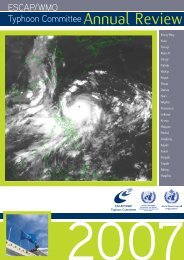TCAR - Typhoon Committee
TCAR - Typhoon Committee
TCAR - Typhoon Committee
You also want an ePaper? Increase the reach of your titles
YUMPU automatically turns print PDFs into web optimized ePapers that Google loves.
the theme of the World Health Day on “Save<br />
Lives - Make Hospitals Safe in Emergencies”. In<br />
addition, the Southeast Asia Disaster Prevention<br />
Institute of the National University of Malaysia held a<br />
national forum on “Hospitals Safe from Disaster” in<br />
conjunction with the World Health Day.<br />
Trainings, seminars and drills are constantly<br />
organized by Government agencies to enhance their<br />
skills and expertise in disaster management as well<br />
as to implement community-based disaster reduction<br />
programs and awareness for vulnerable groups.<br />
In our effort to establish a sustainable and<br />
resilient environment for local communities, the<br />
Government has encouraged the participation<br />
and involvement of non-governmental organizations<br />
(NGO) in disaster risk reduction programs. NGOs and<br />
civil societies play a profound role in exploring a more<br />
proactive function in enhancing public awareness in<br />
disaster risk prevention, mitigation and preparedness.<br />
Malaysia also declared 26 December as the disaster<br />
awareness day since 2005. In 2008, the theme<br />
chosen was “Disaster Risk Reduction on Highland<br />
Development” aimed at promoting disaster risk<br />
reduction measures in development planning.<br />
Safety Guideline in Disaster and Crisis Situation<br />
has been developed and distributed to schools and<br />
community leaders in order to provide awareness<br />
and guideline to the public to response accordingly<br />
to disaster and crisis situation.<br />
2.4.4 Regional Cooperation Achievements/<br />
Results Regional and International Platform<br />
Malaysia was succesfully organised The Third<br />
Asian Ministerial Conference on Disaster Risk<br />
Reduction (AMCDRR) on 2-4 December 2008 in<br />
Kuala Lumpur, Malaysia in collaboration with<br />
United Nations International Strategy for Disaster<br />
Reduction (UNISDR) and other partners. The main<br />
outcome of the Conference, the Kuala Lumpur<br />
Declaration highlighted the importance of Multistakeholder<br />
Partnership for Disaster Risk Reduction<br />
with special emphasis on public-private-partnership<br />
for disaster risk reduction and community-based<br />
disaster risk reduction actions. The Conference was<br />
attended by Ministers and government officials from<br />
43 countries as well as representatives from relevant<br />
international and regional organisations.<br />
Malaysia also involves with international and<br />
regional platforms organised by the Asian<br />
Disaster Reduction Centre (ADRC), Asian Disaster<br />
Preparedness Center (ADPC), <strong>Typhoon</strong> Commitee<br />
(TC), United Nations Office for the Coordination of<br />
<strong>TCAR</strong><br />
CHAPTER 1 - TYPHOON COMMITTEE ACTIVITIES<br />
Humanitarian Affairs (UNOCHA), and its subsidiary<br />
bodies, the United Nations Disaster Assessment<br />
and Coordination (UNDAC) and International Search<br />
and Rescue Advisory Group (INSARAG) as well as<br />
Asia Pacific Economic Cooperation (APEC).<br />
2.5 Improved Capacity to Generate and Provide<br />
Accurate, Timely, and understandable Information<br />
on <strong>Typhoon</strong>-related Threats.<br />
2.5.1 Meteorological Achievements/Results<br />
Hardware and Software Upgrade<br />
Hardware upgrades are being done to the<br />
data storage system of the Numerical Weather<br />
Prediction system at the Malaysian Meteorological<br />
Department. The size of the storage is to increase<br />
by 4 terabytes and the data storage of all three<br />
operational numerical weather systems (Two Shared<br />
Memory Processor SGI 64 blade with each blade<br />
having 2 dual core Intel Itanium processors and a<br />
Linux cluster with two head nodes and nine compute<br />
nodes whereby each node is having four single core<br />
AMD Opteron processors) are to be shared together<br />
using an additional server via a gigabit ethernet<br />
switch.<br />
2.5.2 Research, Training, and Other<br />
Achievements/Results<br />
Research and Training<br />
Current on-going research activities at MMD<br />
include “Heavy Rainfall Episodes During The<br />
Northeast Monsoon Season”, “The Impact of Tropical<br />
Cyclones in the Bay of Bengal On the Rainfall<br />
in Malaysia”, “Verification of the MMD-WAM<br />
Significant Wave Height Gridded Output using In<br />
Situ Measurement and Satellite Derived Data”, “Case<br />
Studies of Northeast Monsoon Surges”, “ Climate<br />
Extremes Projection for Malaysia” and “Preliminary<br />
studies of Ensemble Forecasting at the Malaysian<br />
Meteorological Department”.<br />
The objectives of the “Heavy Rainfall Episodes<br />
During The Northeast Monsoon Season” and “Case<br />
Studies of Northeast Monsoon Surges” studies<br />
are to examine the precursors and maintenance<br />
of heavy rainfall episodes over the east coast of<br />
Peninsular Malaysia and Sarawak during the<br />
Northeast Monsoon season from November to<br />
February.<br />
Rainfall records of local meteorological stations<br />
from 1951 to 2008, reanalysis gridded NCEP data,<br />
ERA40 data from ECMWF and JRA data from JMA<br />
are analyzed to study the evolution of vorticity,<br />
2009<br />
81

















